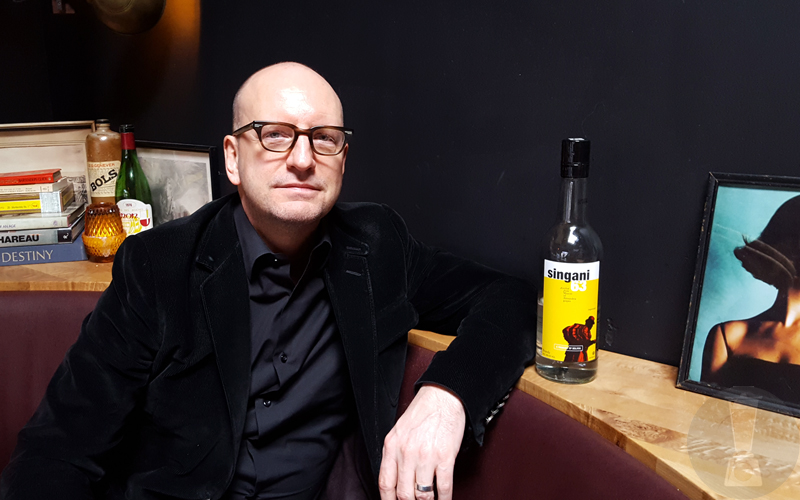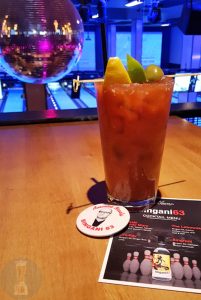
I recognized him right away.
I knew too much, of course. I had spent the morning reading up on him, the acclaimed producer, director, editor, writer. Steven Soderbergh, Oscar winner, consecutive award nominee, with a roster of over 100 films and television episodes bearing his name in some form or another.
I tried not to stare.
The New York resident was in town for business meetings and promotions on behalf of his spirit, Singani 63, socializing with some of Portland’s top bartenders and drink slingers. The singani, classified as a brandy, was favorable in every iteration offered by the Expatriate bar staff but also flexible enough to drink neat. Crisp and floral, its production is unique, made from white Muscat grapes grown above 5000 feet in the Bolivian mountains.
Q: I read that you first tasted the singani while you were filming “Che”.
A: Yeah, we were talking about that yesterday. Someone had said to me, “People get exposed to spirits all the time and they don’t decide to become the importer.” I thought about that. I realized that what it was, that just after I was given it, just after we started filming, I had an immediate response. The person who gave it to me, our Bolivian casting director, made sure we always had some. We’d collect every night in the editing room, and it’d be the editing crew and the camera department for a little over five and a half months, and we were regularly drinking it. I think that’s really what made me think, Ok, let’s do something. If I’d only had it once or twice, I probably wouldn’t have had that response.
Also, as I discovered when I tried other singanis, that if it hadn’t had been the Casa Real version of singani, I don’t think it would’ve happened either. There’s something about the way they produce it, the way they distill it. I think I got lucky with Casa Real. It’s a fourth generation business, and the grandfather, Don Lucho, was the first to formalize the distillation process. Before that, it was very ad hoc, people would do it at their homes, they’d sell it in the park. But Casa Real was the first company to industrialize the production of singani.
Did You See That Movie?
Over the last thirty years, Soderbergh has seen critical success with a number of films, including “Sex, Lies and Videotape”, “Erin Brockovich”, “Traffic”, and “Ocean’s Eleven”. He had his hands in movies like “I’m Not There”, “The Limey”, “Pleasantville”, “Confessions of a Dangerous Mind”, and “The Daytrippers”. In 2000, he found time to pen “Getting Away With It”, a tale on the ups and downs of filmmaking.
He announced his retirement in 2013, but it hasn’t been all singani sipping since. A man with a keen interest in a good story and a smart opportunity, Soderbergh has been involved in both small and big screen projects, as well as forays into multimedia, social media, and of course, spirits. Recent years have included success with shows such as “The Girlfriend Experience” and “The Knick”. And then there’s that stripper movie…

Q: How did Magic Mike come about?
A: That was sort of timing and happy accidents. We were on the set of “Haywire”, and I knew Chan had a production company and a partner, and we were waiting for something to get set up, and I said, “Well, what kind of stuff are you developing?” And he walked me through the five or six things they were developing, and the last one he tossed out was sort of, “Oh yeah, and I got this thing about when I was 19 and stripping in Tampa.” And I went, “Whoa! Whoa! What? Dude. That’s gold. What are you doing with it?” And he said, “Well, we don’t have a script, we don’t have a director.” I said, “You need to step on the gas. That’s a great idea and somebody’s going to do it if you don’t.” He thought my reaction was sort of outsized, but to me, it was so money.
A year later, the next April, he emailed me and asked if I was still interested. So we got together, we sat down and got our hot dog and I said, “This is how it’s going to happen: I’m going to fly to Cannes in three weeks and we’re going to shoot a little teaser trailer,” which we did, in my producer’s bathroom of [Channing Tatum] shaving his legs to a Kiss song. I said, “I’m going to go to Cannes and sell enough territories to pay for the movie, then you and I are going to write the check to make the movie and start shooting in September, so we’ve got to start now.” I just knew. It was a Halley’s Comet. There aren’t ideas like that with somebody great attached. You’re just stupid to not do everything you can.
It’s about the guys. In the first one, the hard part was convincing men that it’s not just for women. It’s a guy movie. It’s about camaraderie and competition, but if you’re a guy, you can watch it. Most of the characters were male. But those were fun to do. Both of them. On the second one, I got to meet Donald Glover, who is just blowing up.
Q: Was it a major shift to go from movies to television?
A: I found it freeing in a way because something like “The Knick,” to have a ten-hour canvas, was really liberating, because you have a chance to deep dive on character stuff that in a movie you’re usually encouraged to eliminate in order maintain this sort of momentum of what I like to call ‘the tyranny of the two-hour format.’ And in “The Knick,” it was all character stuff. You could go as deep as you wanted, and I loved it. Since I was doing all the episodes, we could schedule it and shoot it like a film. A lot of episodic TV, they do one a week, and there’s a different director. Doing it like a film, we could shoot everything we needed at this one location and then move elsewhere. It’s much more economical if you can do it. I had a great time on it.
About That Retirement
Over the next year, Soderbergh will also see the release of two more films – the next installation of the Ocean’s series, “Ocean’s Eight”, directed by Gary Ross featuring an all-female cast; and “Logan Lucky”, starring his pal Channing Tatum in, unsurprisingly, a heist-themed scenario.
Q: Did you always have an innate interest in heists?
A: I did. There’s no rational reason why, as a kid, what I would call caper movies would have such an appeal to me. But they always did. There’s a great film called “The Hot Rock”. It’s really good. Robert Redford, 1972. It’s hilarious. You’ll see how much of an influence it was on the Ocean’s films. That sense of humor. I just like them. That kind of humor and a sort of puzzle. It something that movies are good for.
The good news is the heist genre is sort of a perpetual motion machine. You can always come up with a heist. Because everybody enjoyed those “Ocean’s Eleven” experiences, of making them, it wasn’t as hard as it might be normally. When I look back at how we were able to keep that whole group together, like three movies in six years, you can’t do that now. You just can’t. That was Jerry Weintraub who managed to corral all these cats into one box, but that’s unusual. A lot of that was George, too. He came up with this algorithm for himself, and Matt, and Brad, and said, Look, you can get this same percentage per film, and they all took the same fee for each of the three films. They never got a raise. Everyone else kept getting raises with each film, but had they not done that, we never would’ve been able to do it.
We’re doing the female Ocean’s now. Big names. It’s a good group. It’s going to be good. They’re talking about moving the release up because in this new context, there’s a whole sort of layer to it. Without doing anything, just with the President we have now, there’s a whole new layer to it that never existed before. This group of women deciding to do this thing, and do it themselves, and now it takes on this kind of weight that pre-election it didn’t have.
Q: What else do you have on the table?
A: There’s this experimental narrative piece that I’m really excited about. HBO wants to put another show like it into production. It’ll be on their streaming platform, and you’ll be able to, at certain design points, follow whatever character you want to follow. There’s a story map, and when you get to the end, you can go back and look at all the stuff you missed. We’ve been working on it a long time. The editorial process has been really tricky, and I think we finally found the structure that works. So this summer they’ll do all the tech testing to make sure that if a million people log in, it doesn’t crash. It’s called “Mosaic”.
I have other stuff that I have set up that I’m hoping to do that are in that 6-to-10-hour range.
I shot something when I was at Casa Real, a ten-minute thing about Singani 63 and the business, and I want to expand it. Get more detail. By design, it’s inside baseball. It’s really for bartenders. We’re all going back to Casa Real in March for the harvest, and we’ll be taking a couple people with us, like Alex Day. I want to hear someone like Alex talk to the master distiller so I can get more granular detail, questions that I don’t even know to ask, so I can get the full story of their process and why I feel theirs is so smooth, so floral, and so versatile.
It’s been interesting just immersing yourself into a different business. I was somebody who liked to drink but didn’t really think much beyond the surface of what was in a drink, or why I was even drinking it. Now I feel like bars are ruined because now I walk in and I look at what they’ve got, what they’ve got in the well, what’s on the menu.

~Jennifer Matthewson
Photo credit: Jennifer Matthewson / Daily Blender
